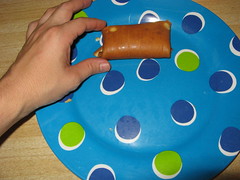Blintz batter:
1 1/2 cups flour
1 1/2 cups milk
4 large eggs
3 tablespoons butter, melted
1 tablespoon sugar
Pinch salt
Butter or oil for cooking the blintzes
Cheese filling:
2 1/2 cups drained small-curd cottage cheese (~20-ounces)
4 ounces cream cheese
2 large eggs
1/4 cup sugar
2 teaspoons vanilla
1/2 teaspoon salt
To make this recipe you need to make the blintz batter and cook it, make the filling, and then fill the blintzes and cook them.
To make the blintz batter:
1. Add all the ingredients for the blintz batter to a blender or food processor and blend or process until smooth, scraping down the sides as necessary.
2. Refrigerate the mixture for at least 30 minutes before cooking.
To make the filling:
0. Drain extra liquid from the cottage cheese: put it into a strainer and let it sit for about half an hour. This step could probably be skipped if you're in a hurry.
1. Add the drained cottage cheese, cream cheese, eggs, sugar, vanilla, and salt to a blender or food processor and process until well mixed. There should be no large lumps left after mixing; chill until needed.
To cook the blintzes:
0. Get out your supplies and arrange them around the stove. You'll need a small to medium non-stick pan, the blintz batter, a measuring device for the batter (a 1/8 or 1/4 cup measurer works well), a spatula to remove the blintzes from the pan, a cooling rack or plate to put the blintzes on once they're cooked, and a paper towel or two to clean up the inevitable drips of batter.
1. Heat the pan over medium or medium-high heat, adding a little butter or oil to the pan before cooking the first blintz.
2. When the pan is warm, add about 2 tablespoons (1/8 cup; half of a 1/4 cup measurer) of blintz batter to the pan, then rotate the pan immediately to distribute the batter into a circle.
3. Once the top of the blintz is no longer liquid and shiny, and the underside is golden brown, slide the blintz out of the pan onto a waiting plate. Look the blintz over to see how it turned out, and adjust the cooking time and the stove's heat level based on this inspection (e.g., if the bottom is browning before the top is cooked, turn the heat down). I have an electric stove with only a few heat settings, so I often find myself switching between two heat levels on the stove to maintain the optimum cooking temperature.
4. Continue cooking (steps 2-3) until you've used all the batter (or made as many blintzes as you want to fill).
To fill the blintzes and cook them:
0. Preheat the oven to 350F.
1. Put an individual blintz on a plate, uncooked side up, and place approximately 1-2 tablespoons of filling onto the center of the blintz.
2. Fold one edge (the bottom) of the blintz up onto the filling, fold the two sides in, and then roll the filled portion of the blintz onto the last unfolded edge (the top). This should leave you with a compact packet of blintz neatly surrounding the cheese filling. Repeat for all the blintzes; see figure 1 for more detail.
3. Arrange all the filled blintzes on a baking sheet (we line ours with a non-stick liner, but this is probably not necessary) so that they're not touching, and bake at 350F for 17-20 minutes (or until the filling is heated through and the outside is crispy).
4. Let cool briefly, and serve.





Figure 1: How to fill a blintz.
Notes:
When I cook the blintzes I use two pans simultaneously and fill the cooked blintzes almost immediately after I've slid them out of the pan (as another pair cook in the pans). If you're a beginner at making blintzes, I'd recommend using just one pan and waiting to fill the blintzes until after you've cooked all the batter.
This recipe is based on one in Joy of Cooking (though we've changed the proportions to make the filling sweeter and have more filling for the blintzes). Joy of Cooking specifies that the filled blintzes should be fried in a few tablespoons of oil in a pan on the stove; while this does result in a slightly crispier outside, it's far more tedious than baking, and thus we usually bake ours.
As making crepes and blintzes is so similar, many of these instructions are copied directly from our crepes with a savory chicken and cheese sauce filling recipe. Note, however, that unlike crepes, blintzes are cooked on only one side before filling.
Reference:
Rombauer, I. S., M. R. Becker, and E. Becker. 1997. Joy of Cooking. Scribner, NY.




